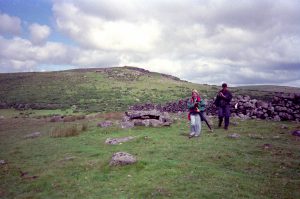 The Prologue of Plague of a Green Man, the second book in my Lady Apollonia West Country Mystery series, opens in a blinding fog on Dartmoor not far from the city of Exeter in Devon in the year 1380. Dartmoor is southwest of Exeter where I lived with my husband in the late 1980’s and in the 1990’s. In 1951 Dartmoor became the first English national park covering an area of 368 square miles.
The Prologue of Plague of a Green Man, the second book in my Lady Apollonia West Country Mystery series, opens in a blinding fog on Dartmoor not far from the city of Exeter in Devon in the year 1380. Dartmoor is southwest of Exeter where I lived with my husband in the late 1980’s and in the 1990’s. In 1951 Dartmoor became the first English national park covering an area of 368 square miles.
There are signs of human life from the Neolithic period or New Stone Age but Dartmoor was sparsely populated until the early Bronze Age. Then, things changed. Archaeologists have found the largest collection of Bronze Age remains in all of Britain on Dartmoor. The climate was warmer in the Bronze Age, and a good-sized human population had moved into these uplands clearing the forests for farming. They created tracts of open moorland which eventually, as the climate cooled, became less hospitable and eventually covered with heather. It was eventually abandoned and no longer cultivated.
Much of our hiking on Dartmoor helped Lou and me to learn of interesting survivors of the pre-historic period: menhirs or standing stones, man-made rows of standing stones, as well as cists or burial tombs, and cairns or human-made stacks of stones. A cist near Postbridge is pictured above. The remains of an estimated 1500 hut circles are scattered throughout Dartmoor. In the Bronze Age, Grimspound, a place mentioned in my story, contained 24 huts within a stone enclosure of about four acres. The remains of this settlement have been excavated and can be visited.
We often encountered clapper bridges, made of horizontal slabs of stone, usually granite, which are another ancient and unique feature of the moor. There is a large one in Postbridge dating back to at least 1380. Other smaller clapper bridges, perhaps much older, are scattered around Dartmoor. Many of the towns and villages of Dartmoor date back to the medieval period, and our hikes took us to one medieval village, located near Hound Tor that survives only in ruins. We never learned why it was abandoned.
More recent history of Dartmoor involves extensive extraction of granite from the moor to build such things as the early 19th century London Bridge. One can find unused corbels for this bridge near Swelltor Quarry as well as evidence of the former narrow gauge railway that once ran from Plymouth to Dartmoor. When this London bridge was replaced in the 20th century, it was moved to Arizona. A very different early 19th century development on Dartmoor is the prison built at Princetown by French and American prisoners of War. We found a stained-glass window in the church in Princetown given by the Daughters of the War of 1812 to commemorate the American prisoners who also helped to build that church.
For more information on Dartmoor, click on
https://en.wikipedia.org/wiki/Dartmoor .
Tags: Chaucer's England, historical fiction, medieval mysteries